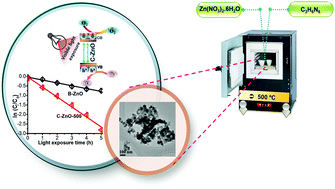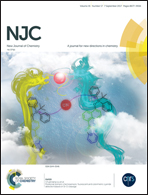Facile and sustainable synthesis of carbon-doped ZnO nanostructures towards the superior visible light photocatalytic performance†
Abstract
This paper reports a facile and one-step thermal decomposition method for the fabrication of carbon-doped ZnO (C-ZnO) at different temperatures using commercially available melamine and zinc nitrate hexahydrate as the starting materials. The resulting photocatalyst, i.e., bare ZnO (B-ZnO) and C-ZnO, was characterized using a range of spectroscopic and microscopic techniques. The photocatalytic performance of the as-prepared photocatalyst was assessed by the degradation of a model pollutant, rhodamine B, under visible light irradiation. C-ZnO exhibited a significantly higher degradation response than B-ZnO, which could be attributed to the narrow band gap and improved electron/hole separation efficiency, as confirmed by UV-vis diffuse absorption/reflectance, photoluminescence and electrochemical impedance spectroscopy. Linear scan voltammetry in the dark and under visible light exposure showed that C-ZnO possessed a higher photocurrent than B-ZnO under similar experimental conditions. The proposed method has great potential for the developing nanocatalysts by a simple thermal decomposition method that can be commercialized.



 Please wait while we load your content...
Please wait while we load your content...